Shiyu Liu
University of Michigan
Motion Planning and Control of an Overactuated 4-Wheel Drive with Constrained Independent Steering
Oct 21, 2025Abstract:This paper addresses motion planning and con- trol of an overactuated 4-wheel drive train with independent steering (4WIS) where mechanical constraints prevent the wheels from executing full 360-degree rotations (swerve). The configuration space of such a robot is constrained and contains discontinuities that affect the smoothness of the robot motion. We introduce a mathematical formulation of the steering constraints and derive discontinuity planes that partition the velocity space into regions of smooth and efficient motion. We further design the motion planner for path tracking and ob- stacle avoidance that explicitly accounts for swerve constraints and the velocity transition smoothness. The motion controller uses local feedback to generate actuation from the desired velocity, while properly handling the discontinuity crossing by temporarily stopping the motion and repositioning the wheels. We implement the proposed motion planner as an extension to ROS Navigation package and evaluate the system in simulation and on a physical robot.
NeuroVoxel-LM: Language-Aligned 3D Perception via Dynamic Voxelization and Meta-Embedding
Jul 27, 2025Abstract:Recent breakthroughs in Visual Language Models (VLMs) and Multimodal Large Language Models (MLLMs) have significantly advanced 3D scene perception towards language-driven cognition. However, existing 3D language models struggle with sparse, large-scale point clouds due to slow feature extraction and limited representation accuracy. To address these challenges, we propose NeuroVoxel-LM, a novel framework that integrates Neural Radiance Fields (NeRF) with dynamic resolution voxelization and lightweight meta-embedding. Specifically, we introduce a Dynamic Resolution Multiscale Voxelization (DR-MSV) technique that adaptively adjusts voxel granularity based on geometric and structural complexity, reducing computational cost while preserving reconstruction fidelity. In addition, we propose the Token-level Adaptive Pooling for Lightweight Meta-Embedding (TAP-LME) mechanism, which enhances semantic representation through attention-based weighting and residual fusion. Experimental results demonstrate that DR-MSV significantly improves point cloud feature extraction efficiency and accuracy, while TAP-LME outperforms conventional max-pooling in capturing fine-grained semantics from NeRF weights.
SecFwT: Efficient Privacy-Preserving Fine-Tuning of Large Language Models Using Forward-Only Passes
Jun 18, 2025Abstract:Large language models (LLMs) have transformed numerous fields, yet their adaptation to specialized tasks in privacy-sensitive domains, such as healthcare and finance, is constrained by the scarcity of accessible training data due to stringent privacy requirements. Secure multi-party computation (MPC)-based privacy-preserving machine learning offers a powerful approach to protect both model parameters and user data, but its application to LLMs has been largely limited to inference, as fine-tuning introduces significant computational challenges, particularly in privacy-preserving backward propagation and optimizer operations. This paper identifies two primary obstacles to MPC-based privacy-preserving fine-tuning of LLMs: (1) the substantial computational overhead of backward and optimizer processes, and (2) the inefficiency of softmax-based attention mechanisms in MPC settings. To address these challenges, we propose SecFwT, the first MPC-based framework designed for efficient, privacy-preserving LLM fine-tuning. SecFwT introduces a forward-only tuning paradigm to eliminate backward and optimizer computations and employs MPC-friendly Random Feature Attention to approximate softmax attention, significantly reducing costly non-linear operations and computational complexity. Experimental results demonstrate that SecFwT delivers substantial improvements in efficiency and privacy preservation, enabling scalable and secure fine-tuning of LLMs for privacy-critical applications.
Step1X-Edit: A Practical Framework for General Image Editing
Apr 24, 2025Abstract:In recent years, image editing models have witnessed remarkable and rapid development. The recent unveiling of cutting-edge multimodal models such as GPT-4o and Gemini2 Flash has introduced highly promising image editing capabilities. These models demonstrate an impressive aptitude for fulfilling a vast majority of user-driven editing requirements, marking a significant advancement in the field of image manipulation. However, there is still a large gap between the open-source algorithm with these closed-source models. Thus, in this paper, we aim to release a state-of-the-art image editing model, called Step1X-Edit, which can provide comparable performance against the closed-source models like GPT-4o and Gemini2 Flash. More specifically, we adopt the Multimodal LLM to process the reference image and the user's editing instruction. A latent embedding has been extracted and integrated with a diffusion image decoder to obtain the target image. To train the model, we build a data generation pipeline to produce a high-quality dataset. For evaluation, we develop the GEdit-Bench, a novel benchmark rooted in real-world user instructions. Experimental results on GEdit-Bench demonstrate that Step1X-Edit outperforms existing open-source baselines by a substantial margin and approaches the performance of leading proprietary models, thereby making significant contributions to the field of image editing.
Centaur: Bridging the Impossible Trinity of Privacy, Efficiency, and Performance in Privacy-Preserving Transformer Inference
Dec 14, 2024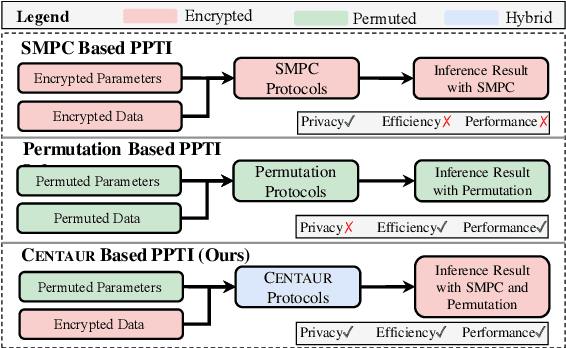

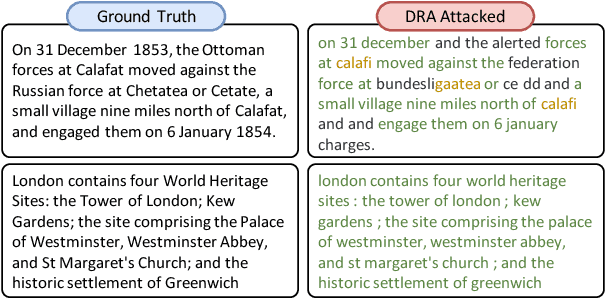
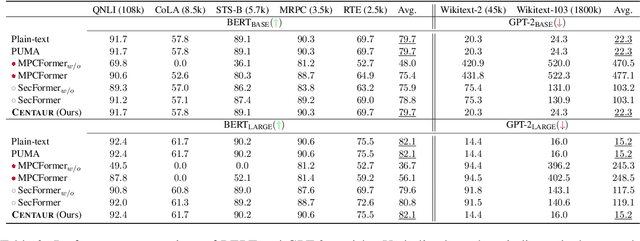
Abstract:As pre-trained models, like Transformers, are increasingly deployed on cloud platforms for inference services, the privacy concerns surrounding model parameters and inference data are becoming more acute. Current Privacy-Preserving Transformer Inference (PPTI) frameworks struggle with the "impossible trinity" of privacy, efficiency, and performance. For instance, Secure Multi-Party Computation (SMPC)-based solutions offer strong privacy guarantees but come with significant inference overhead and performance trade-offs. On the other hand, PPTI frameworks that use random permutations achieve inference efficiency close to that of plaintext and maintain accurate results but require exposing some model parameters and intermediate results, thereby risking substantial privacy breaches. Addressing this "impossible trinity" with a single technique proves challenging. To overcome this challenge, we propose Centaur, a novel hybrid PPTI framework. Unlike existing methods, Centaur protects model parameters with random permutations and inference data with SMPC, leveraging the structure of Transformer models. By designing a series of efficient privacy-preserving algorithms, Centaur leverages the strengths of both techniques to achieve a better balance between privacy, efficiency, and performance in PPTI. We comprehensively evaluate the effectiveness of Centaur on various types of Transformer models and datasets. Experimental results demonstrate that the privacy protection capabilities offered by Centaur can withstand various existing model inversion attack methods. In terms of performance and efficiency, Centaur not only maintains the same performance as plaintext inference but also improves inference speed by $5.0-30.4$ times.
A Learning Rate Path Switching Training Paradigm for Version Updates of Large Language Models
Oct 05, 2024
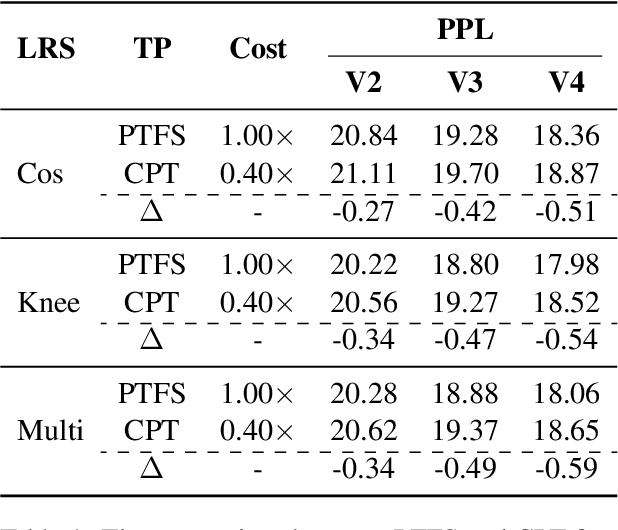


Abstract:Due to the continuous emergence of new data, version updates have become an indispensable requirement for Large Language Models (LLMs). The training paradigms for version updates of LLMs include pre-training from scratch (PTFS) and continual pre-training (CPT). Preliminary experiments demonstrate that PTFS achieves better pre-training performance, while CPT has lower training cost. Moreover, their performance and training cost gaps widen progressively with version updates. To investigate the underlying reasons for this phenomenon, we analyze the effect of learning rate adjustments during the two stages of CPT: preparing an initialization checkpoint and continual pre-training based on this checkpoint. We find that a large learning rate in the first stage and a complete learning rate decay process in the second stage are crucial for version updates of LLMs. Hence, we propose a learning rate path switching training paradigm. Our paradigm comprises one main path, where we pre-train a LLM with the maximal learning rate, and multiple branching paths, each of which corresponds to an update of the LLM with newly-added training data. Extensive experiments demonstrate the effectiveness and generalization of our paradigm. Particularly, when training four versions of LLMs, our paradigm reduces the total training cost to 58% compared to PTFS, while maintaining comparable pre-training performance.
Reducing Semantic Ambiguity In Domain Adaptive Semantic Segmentation Via Probabilistic Prototypical Pixel Contrast
Sep 27, 2024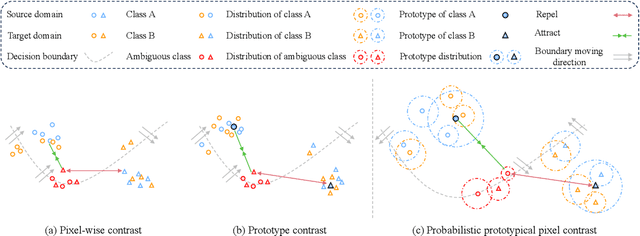
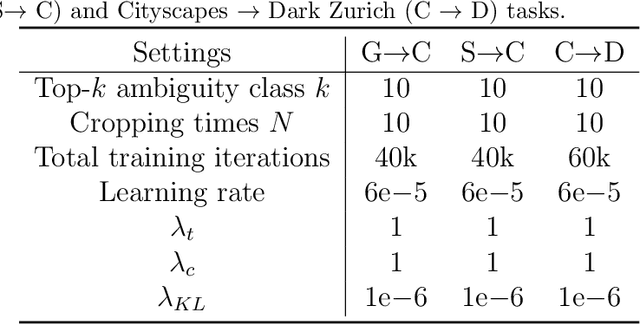
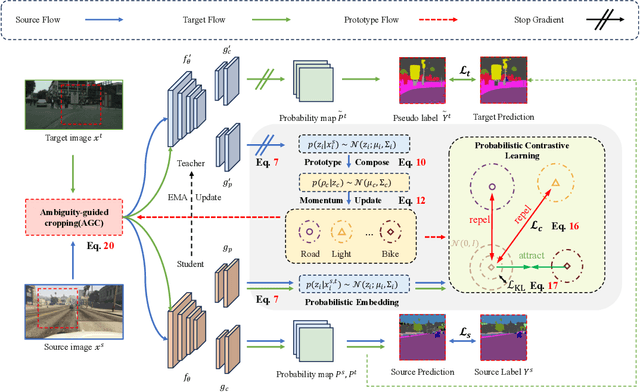
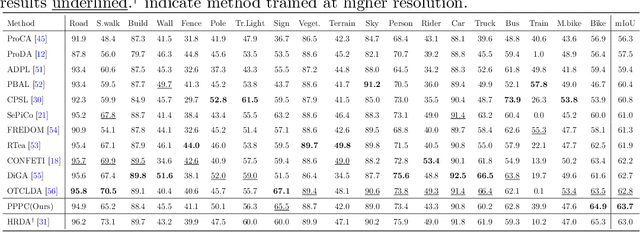
Abstract:Domain adaptation aims to reduce the model degradation on the target domain caused by the domain shift between the source and target domains. Although encouraging performance has been achieved by combining cognitive learning with the self-training paradigm, they suffer from ambiguous scenarios caused by scale, illumination, or overlapping when deploying deterministic embedding. To address these issues, we propose probabilistic proto-typical pixel contrast (PPPC), a universal adaptation framework that models each pixel embedding as a probability via multivariate Gaussian distribution to fully exploit the uncertainty within them, eventually improving the representation quality of the model. In addition, we derive prototypes from probability estimation posterior probability estimation which helps to push the decision boundary away from the ambiguity points. Moreover, we employ an efficient method to compute similarity between distributions, eliminating the need for sampling and reparameterization, thereby significantly reducing computational overhead. Further, we dynamically select the ambiguous crops at the image level to enlarge the number of boundary points involved in contrastive learning, which benefits the establishment of precise distributions for each category. Extensive experimentation demonstrates that PPPC not only helps to address ambiguity at the pixel level, yielding discriminative representations but also achieves significant improvements in both synthetic-to-real and day-to-night adaptation tasks. It surpasses the previous state-of-the-art (SOTA) by +5.2% mIoU in the most challenging daytime-to-nighttime adaptation scenario, exhibiting stronger generalization on other unseen datasets. The code and models are available at https://github.com/DarlingInTheSV/Probabilistic-Prototypical-Pixel-Contrast.
Strawberry detection and counting based on YOLOv7 pruning and information based tracking algorithm
Jul 17, 2024Abstract:The strawberry industry yields significant economic benefits for Florida, yet the process of monitoring strawberry growth and yield is labor-intensive and costly. The development of machine learning-based detection and tracking methodologies has been used for helping automated monitoring and prediction of strawberry yield, still, enhancement has been limited as previous studies only applied the deep learning method for flower and fruit detection, which did not consider the unique characteristics of image datasets collected by the machine vision system. This study proposed an optimal pruning of detection heads of the deep learning model (YOLOv7 and its variants) that could achieve fast and precise strawberry flower, immature fruit, and mature fruit detection. Thereafter, an enhanced object tracking algorithm, which is called the Information Based Tracking Algorithm (IBTA) utilized the best detection result, removed the Kalman Filter, and integrated moving direction, velocity, and spatial information to improve the precision in strawberry flower and fruit tracking. The proposed pruning of detection heads across YOLOv7 variants, notably Pruning-YOLOv7-tiny with detection head 3 and Pruning-YOLOv7-tiny with heads 2 and 3 achieved the best inference speed (163.9 frames per second) and detection accuracy (89.1%), respectively. On the other hand, the effect of IBTA was proved by comparing it with the centroid tracking algorithm (CTA), the Multiple Object Tracking Accuracy (MOTA) and Multiple Object Tracking Precision (MOTP) of IBTA were 12.3% and 6.0% higher than that of CTA, accordingly. In addition, other object-tracking evaluation metrics, including IDF1, IDR, IDP, MT, and IDs, show that IBTA performed better than CTA in strawberry flower and fruit tracking.
Efficient k-Nearest-Neighbor Machine Translation with Dynamic Retrieval
Jun 10, 2024
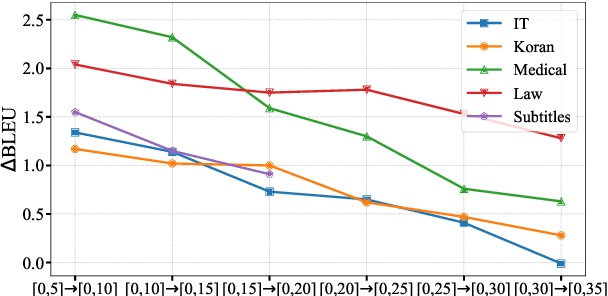

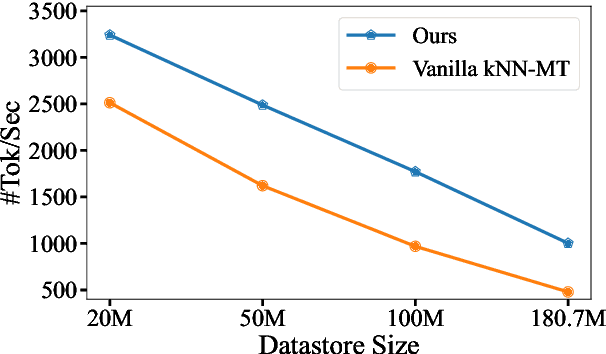
Abstract:To achieve non-parametric NMT domain adaptation, $k$-Nearest-Neighbor Machine Translation ($k$NN-MT) constructs an external datastore to store domain-specific translation knowledge, which derives a $k$NN distribution to interpolate the prediction distribution of the NMT model via a linear interpolation coefficient $\lambda$. Despite its success, $k$NN retrieval at each timestep leads to substantial time overhead. To address this issue, dominant studies resort to $k$NN-MT with adaptive retrieval ($k$NN-MT-AR), which dynamically estimates $\lambda$ and skips $k$NN retrieval if $\lambda$ is less than a fixed threshold. Unfortunately, $k$NN-MT-AR does not yield satisfactory results. In this paper, we first conduct a preliminary study to reveal two key limitations of $k$NN-MT-AR: 1) the optimization gap leads to inaccurate estimation of $\lambda$ for determining $k$NN retrieval skipping, and 2) using a fixed threshold fails to accommodate the dynamic demands for $k$NN retrieval at different timesteps. To mitigate these limitations, we then propose $k$NN-MT with dynamic retrieval ($k$NN-MT-DR) that significantly extends vanilla $k$NN-MT in two aspects. Firstly, we equip $k$NN-MT with a MLP-based classifier for determining whether to skip $k$NN retrieval at each timestep. Particularly, we explore several carefully-designed scalar features to fully exert the potential of the classifier. Secondly, we propose a timestep-aware threshold adjustment method to dynamically generate the threshold, which further improves the efficiency of our model. Experimental results on the widely-used datasets demonstrate the effectiveness and generality of our model.\footnote{Our code is available at \url{https://github.com/DeepLearnXMU/knn-mt-dr}.
VCISR: Blind Single Image Super-Resolution with Video Compression Synthetic Data
Nov 02, 2023Abstract:In the blind single image super-resolution (SISR) task, existing works have been successful in restoring image-level unknown degradations. However, when a single video frame becomes the input, these works usually fail to address degradations caused by video compression, such as mosquito noise, ringing, blockiness, and staircase noise. In this work, we for the first time, present a video compression-based degradation model to synthesize low-resolution image data in the blind SISR task. Our proposed image synthesizing method is widely applicable to existing image datasets, so that a single degraded image can contain distortions caused by the lossy video compression algorithms. This overcomes the leak of feature diversity in video data and thus retains the training efficiency. By introducing video coding artifacts to SISR degradation models, neural networks can super-resolve images with the ability to restore video compression degradations, and achieve better results on restoring generic distortions caused by image compression as well. Our proposed approach achieves superior performance in SOTA no-reference Image Quality Assessment, and shows better visual quality on various datasets. In addition, we evaluate the SISR neural network trained with our degradation model on video super-resolution (VSR) datasets. Compared to architectures specifically designed for the VSR purpose, our method exhibits similar or better performance, evidencing that the presented strategy on infusing video-based degradation is generalizable to address more complicated compression artifacts even without temporal cues.
 Add to Chrome
Add to Chrome Add to Firefox
Add to Firefox Add to Edge
Add to Edge